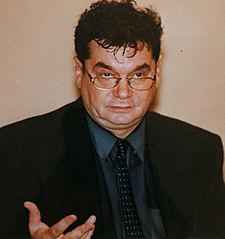Marcel Paquet facts for kids
Quick facts for kids
Marcel Paquet
|
|
|---|---|

Marcel Paquet
|
|
| Born | 21 February 1947 |
| Died | 22 November 2014 (aged 67) |
| Nationality | Belgian |
| Era | 20th-century philosophy |
| Region | Western philosophy |
|
Main interests
|
Ontology • Political Philosophy Esthetics |
Marcel Paquet (born February 21, 1947 – died November 22, 2014) was a Belgian philosopher. He was a deep thinker who explored many important ideas.
Some of the biggest thinkers who inspired him were Spinoza, Kant, Hegel, Nietzsche, Heidegger, and Michel Foucault.
Paquet believed we should focus on the real world we can experience with our senses. He thought that humans are part of nature. He also believed that our thoughts come from our brains, often without us even realizing it. He felt that our bodies are very important, and our conscious mind mostly just sees the results of our thoughts, rather than creating them.
He was inspired by Nietzsche's idea of "Eternal Recurrence". Paquet saw this as a way to understand ourselves better. It helped him think about what makes us truly ourselves, beyond what society or culture tells us. He believed that connecting with our bodies was the most important ethical value.
Paquet explored these ideas in different areas. He wrote about ontology (the study of being), political philosophy (how societies should be run), and esthetics (the study of beauty and art). He was especially interested in painting, which he saw as a way to make sensory experiences visible. He wrote many essays about artists he knew, like Jean Dubuffet, Alexander Calder, André Masson, Magritte, Paul Delvaux, Fernando Botero, and others.
He also wrote several philosophical novels. These included Renaissance sécondaire, Merde à Jésus, L’affaire Socrate, and Marie et les Jean. Marcel Paquet passed away in Poznań, Poland, in 2014.
Contents
Marcel Paquet's Life
Marcel Paquet was born in Jumet, a town near Charleroi in Belgium. He often said that he had a difficult childhood. He found comfort and escape in books. Two books that especially influenced him were Spinoza's Ethics and Nietzsche's Antichrist.
Discovering Art and Ideas
A school trip to London helped him discover the paintings of William Turner. Later, a visit to Amsterdam sparked his love for the works of Rembrandt and Van Gogh. In Amsterdam, he also met Constant, a painter and architect. Paquet even translated Constant's work, Het Opstand van de Homo ludens (The uprising of Homo Ludens), into French.
University and Early Career
In 1964, Paquet started studying at the Free University of Brussels. By 1967, he became an assistant to Professor Pierre Verstraeten. His final university paper explored the idea of unity in Kant's thinking.
In 1971, he joined the Belgian National Fund for Scientific Research. He researched topics like fanaticism. His essay, "Essai sur l’absolu" (Essay on the concept of the Absolute), caught the attention of French philosopher Gérard Lebrun. This led to Paquet becoming a professor of German Philosophy at the University of Tunis.
Time in Tunis and New Ventures
From 1972 to 1974, Paquet lived in Tunis. During this time, he wrote his first published book, L’enjeu de la philosophie (The Question of Philosophy). He also started working on his doctoral paper, which compared the ideas of Kant and Hegel on the meaning of art.
In 1975, he helped start a publishing company called Les Éditions de la Différence. In 1978, he earned his doctorate degree. He continued to study and write about painting, focusing on artists like Magritte, Paul Delvaux, and Fernando Botero.
International Experiences
In 1981, Paquet participated in a conference in Canada. He presented his unique idea of "dansité", a word he created that combines "innerness" and "dance." This idea later appeared in his book about Magritte.
He then lived in Canada for a while, in both Ontario and Quebec. In 1988, he taught French literature at the University of Udine in Italy.
Return to Belgium and Later Work
After returning to Belgium, he met artist Bram Bogart and wrote several articles about his work. In 1990, in Paris, he met artists from the "New New Painting" group. He developed theories about their art, which were published in a book.
In 1993, he founded the "École européenne de philosophie de Charleroi" (European School of Philosophy of Charleroi). This school offered courses on ideas like "ethical conciliation" and even a draft political constitution for Wallonia.
In 1996, he moved to Biarritz. The next year, he married the painter Anna Wilczynska-Wilska. He organized art shows for Bram Bogart and events for other artists, including Amann, and a movement called "New Pigmentation."

